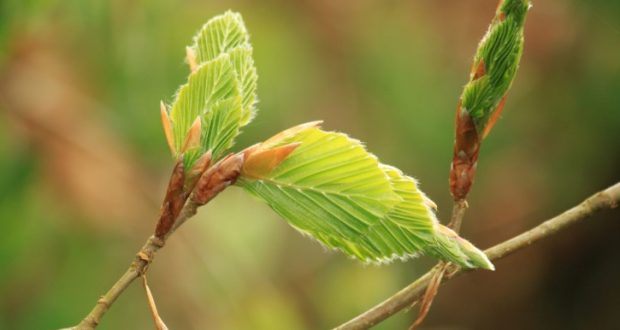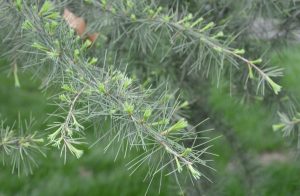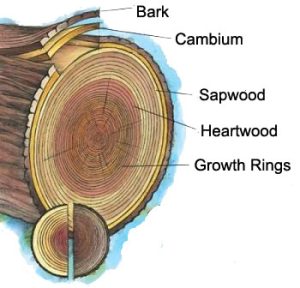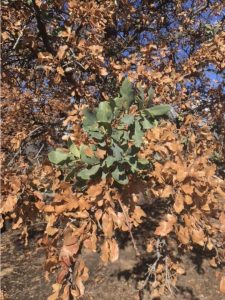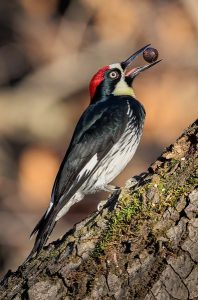By Michele Nowak-Sharkey, UC Master Gardener of Mariposa County.
MARIPOSA — The impulse after a fire is to remove all evidence that the event occurred. This is understandable from an emotional perspective, however, if we shift to the nature lens we see a different approach.
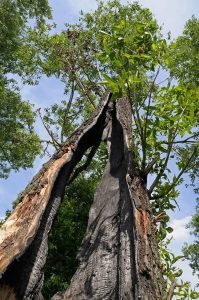 Although the landscape looks blackened with no visible signs of life, life nonetheless is rearranging, communicating, and developing a plan as it shakes off the fire trauma.
Although the landscape looks blackened with no visible signs of life, life nonetheless is rearranging, communicating, and developing a plan as it shakes off the fire trauma.
Trees have a huge impact on ecosystem recovery. Trees contribute by providing oxygen, improving air quality, climate amelioration, conserving water, preserving soil, and supporting wildlife, to say nothing of the joy we humans experience when we interact with our leafed friends through recreation, food gathering or simply viewing.
Structurally unsound trees that threaten buildings and roads need to be felled. However, it is advised to wait one to three years after a fire to determine if a tree will recover, especially larger, more valuable trees. In wildfire recovery, we need to Give Trees A Chance.
Identify: Know your trees. Mariposa County has a diverse mix of pine species, oak varieties, plus firs, manzanita, buckeyes, sycamores and more.
Knowing tree types supplies information about their coping mechanisms with fire, possibility of when they will bring on new leaves or needles, if they will re-sprout from the crown and base of the tree or have seeds that will sprout following a fire.
Other factors that impact tree survival include growth stage at the time of fire, how close together trees were, the chemical and physical characteristics – oil or wax content, vegetation underneath, the season and drought conditions.
Sources for tree identification:
There are also phone apps that can assist too.
Appraise: Leaf or needle scorch, root/trunk/branch damage, cambium (the inner layer between the bark and the wood) injury and bud death are signs of fire damage. These factors alone don’t indicate a tree is dead.
A tree with blackened bark might not look savable. The Ponderosa pine, as it matures, develops a thicker bark that is more fire-resistant. If the bark hasn’t been completely burned off the trunk, exposing the cambium, the tree may survive.
With blackened trees cut a quarter-sized piece, one-half inch through the bark. If you see a green or white moist cambial layer right below the bark, the tree will probably recuperate. Check burned branches- peel back a bit of bark. If there is a thin white or green layer those twigs or branches may be alive.
Look for burned roots around the base and several feet away. Roots are 6-8 inches below the surface. Gently unearth roots in a few locations. If they are supple, not brittle or dried out, survival is good. If 50% of the roots are burned, the tree is unstable.
Burned leaves and needles might be attached to a live tree. New leaves may sprout from the crown or base of the tree. As witnessed in this picture of an oak from the Telegraph fire, the leaves over most of the tree were scorched but within a year, new green leaves sprouted.
It is important to look for buds. If they are green and moist, not dry, and brittle or twigs bend easily, survival is good.
Support: Water trees once the scorched crust layer on soil is cared for. Slowly soak the entire area under the dripline and beyond a few feet to a depth of 12 inches. Do not water the trunk just the surrounding area. Check trees weekly. Water when the soil dries to 6 inches deep.
Protect trunks and large limbs from sunburn until leaf and needles regrow. Loosely wrap in permeable light-colored cloth or cardboard. During fall, prune dead, broken limbs.
Taking Care of Residential Trees after Wildfire (PDF)
Watch: Kris Randal, UC Master Gardener, CA, Naturalist/Oak Specialist, says dead trees have value too! More than 80 species of birds rely on dead trees for nesting and food. Acorn woodpeckers establish large granaries in dead oaks and conifers.
Insects, fungi and more than 300 different types of wildlife rely on dead trees also. Consider leaving a few standing dead trees if they don’t present a hazard.
Spend the first year after fire watching as life surfaces once more. Be a patient partner, give trees AND nature a chance.
Next: To Seed or Not to Seed
UC Master Gardeners of Mariposa County are located at 5009 Fairgrounds Road, Mariposa. For more gardening and event information, visit their website or Facebook page (UC Master Gardeners of Mariposa County).
UC Master Gardeners staff a helpline serving Mariposa County, including Greeley Hill, Coulterville, and Lake Don Pedro. Please contact them at 209-966-7078 or via e-mail at mgmariposa@ucdavis.edu.
Listen to them on the radio at KRYZ 98.5 FM on Wednesdays at 2 p.m and Saturdays at 5 p.m.
Check out this great video on post-wildfire survival and regeneration!

